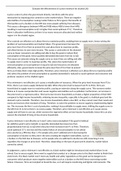Evaluate the effectiveness of a price minimum for alcohol (20)
A price control is when the government directly, interferes with the price
mechanism by imposing price controls to solve market failure. There are negative
externalities of consumption causing market failure as firms ignore the benefits of
third parties such a burden on the NHS due more people suffering from diseases.
This causes a divergence between MPB and MSB where MSB is lower than MPB,
resulting in overconsumption as Q1 is higher than social optimum P*Q*. Therefore,
there is allocative inefficiency as there is too many resources allocated and welfare
region is in the shaded region.
Price controls are effective as it allows firms to maximise profits, enabling them to supply more, hence solving the
problem of overconsumption and market failure. The government increases the
price level from P1 to Pmin to protect firm and allow them to maximise profits,
and allow farmers to earn more income. This causes a contraction in the demand
curve as fewer consumers are willing and able to buy the good or reduce their
consumption of the good, hence quantity demanded decreases from Q1 to QD.
This causes an extension along the supply curve as more firms are willing and able
to supply more in order to maximise profits. This solves the market failure of
overconsumption as social optimum is equal to QD and resources are allocated
efficiently. Also, governments increase the price level from P1 to Pmin to protect
firms as it helps them retain high profits. Therefore, price minimum is effective as it allows firms to maximise profits
and solves the problem of overconsumption as quantity demanded is reduced to social optimum and consumer and
producer surplus is in the shaded region.
Price minimum is not effective as it causes a misallocation of resources. When the price level increases from P1 to
Pmin, there is an excess supply (between Qs-QD). When the price level increases from P1 to Pmin, firms are
incentivised to supply more to maximise profits, causing an extension along the supply curve. This worsens market
failure as it causes overproduction and causes negative externalities such as pollution. Furthermore, an increase in
the price level is a regressive policy. This harms low-income households as it takes a higher proportion of their RDY
compared to high income households, widening income inequality, especially is the good is a habitual good and the
demand is price inelastic. Therefore, low-income households obtain a low RDY, so they cannot meet their needs and
wants and worsens their standard of living. Therefore, to solve the problem to excess supply by implementing higher
tax. This increases the firm’s cost of production, making it less profitable to supply more, shifting the supply curve to
the left from S1 to S2 so there’s no excess supply. Therefore, price minimum is not effective as it causes excess
supply and will have to use tax, which worsens the regressive effect on low-income households, hence this can also
worsen the standard of living of low-income households.
A price minimum is not effective as it won’t solve overconsumption if the good is habitual.
An addictive good Is price inelastic so quantity demanded decreases less than
proportionately from Q1 to QD when the price level increases from P1 to Pmin. Therefore,
social optimum Q* is not met and the market failure of overconsumption is not solved
since alcohol as a PED less than 1. The people who aren’t addicted aren’t decreasing the
consumption of alcohol so they aren’t the ones creating the negative externalities, such as
a burden on the NHS due to diseases, so the people who are addicted to alcohol are still consuming it a lot,
regardless the changes in price level. Therefore, depending on the type of good and its elasticity, market failure
cannot be solved.
In judgement, a price minimum is not effective as a black market might be introduced and market failure is not
solved. Due to excess supply, firms want to supply their product at a cheaper price to the black market to finish their
stock levels. The black market won’t meet any health and safety regulations so the good can be dangerous to
consumers which produces more negative externalities such as a burden on the NHS hence worsening market
failure. Moreover, firms are tempted to break the law, so it will require monitoring and tighter enforcements. This




